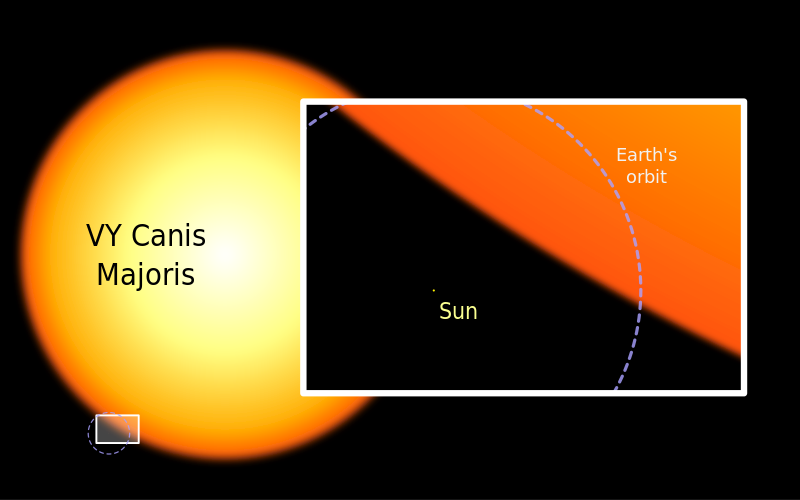
here is a link to the wikipedia article:
http://en.wikipedia.org/wiki/VY_Canis_Majoris[/img]

t00fri wrote:What do you mean? Of course, VY CMa is in Celestia. But stars can have MANY different names. Celestia uses the HIPARCOS catalog (as you might know). Hence you must search for the HIP equivalent of VY CMa, which is
HIP 35793 (didn't you know this by heart?)
or it's HD number
HD 58061
or it's SAO number
SAO 173591
Content?
Bye Fridger
FaLLeN_SOuL wrote:i can't find it under anyone of this namest00fri wrote:What do you mean? Of course, VY CMa is in Celestia. But stars can have MANY different names. Celestia uses the HIPARCOS catalog (as you might know). Hence you must search for the HIP equivalent of VY CMa, which is
HIP 35793 (didn't you know this by heart?)
or it's HD number
HD 58061
or it's SAO number
SAO 173591
Content?
Bye Fridger
FaLLeN_SOuL wrote:i can't find it under anyone of this names

Johaen wrote:Note that it's nowhere near as big in Celestia as the wiki article claims it to be. Its radius is "only" about .4 AU.
Cham wrote:Johaen wrote:Note that it's nowhere near as big in Celestia as the wiki article claims it to be. Its radius is "only" about .4 AU.
This is one of the "bugs" I've described in my "bugs list", recently. Currently, Celestia is giving some **VERY WRONG** radius values to most red (cool) stars. Celestia should be updated on that front : it's way too approximate.
granthutchison wrote:The bolometric corrections used in the lookup table are pretty standard values: so our estimate of total energy output is likely to be reasonably accurate, assuming the spectral class is correct.
The problem comes with the black-body calculation that uses energy output and temperature to calculate surface area, and hence radius. Limb darkening, absorption lines and perhaps large spots all make the black-body assumption faulty for cool stars, and all of the above reduce the actually radiative efficiency of a star's surface, causing Celestia to make it misleadingly small.
I doubt if there is a scientific approach that could generate accurate radii for red giants and supergiants without using prohibitively complex calculations. The alternative, as far as I can see, is yet another lookup table, which lists a set of jigger factors determined by the difference between the naive black-body radii as calculated by Celestia and the real radii derived from proper calculations. (We'd need to make sure planet temperatures were calculated from the original bolometric correction, rather than using temperature and this new corrected radius. I can't remember what's actually used at present.)
But given Fridger's desire for purity in these matters, I do wonder if such a cludged approach would be acceptable to him.
...
Grant
granthutchison wrote:There's your answer, guys.
Adieu.
Grant
Code: Select all
The problem comes with the black-body calculation that uses energy output and temperature to calculate surface area, and hence radius. Limb darkening, absorption lines and perhaps large spots all make the black-body assumption faulty for cool stars, and all of the above reduce the actually radiative efficiency of a star's surface, causing Celestia to make it misleadingly small.
I doubt if there is a scientific approach that could generate accurate radii for red giants and supergiants without using prohibitively complex calculations. The alternative, as far as I can see, is yet another lookup table, which lists a set of jigger factors determined by the difference between the naive black-body radii as calculated by Celestia and the real radii derived from proper calculations.
Cham wrote:Whatever what Fridger thinks, that "purity" concept is a thorn in the foot (it's also recalling me the "purity of the race" idea). It's preventing the development of some very interesting features, even if they are approximate. Currently, Celestia is TOTALLY unreliable about its stars. In many cases, it gives completely wrong and absurd radii, so the user can't trust the rest of the database because of these **important** cases (most cool red stars, dwarfs and giants). Celestia is losing credibility, because of this (many of my students were asking embarrassing questions, recently, about the size of stars in Celestia. I'm losing time to explain what is going on in the software). Celestia should AT THE VERY LEAST warn the user that the displayed radius is unreliable.
At the very least, I suggest that Celestia adds the comment "?", next to the radius of all the cool stars.